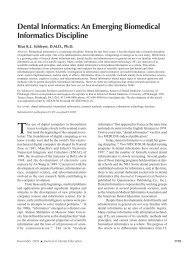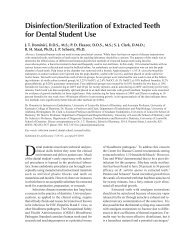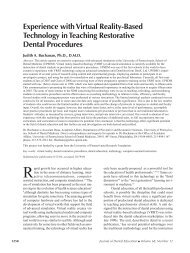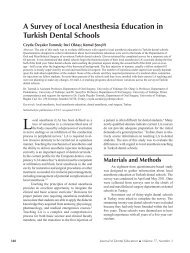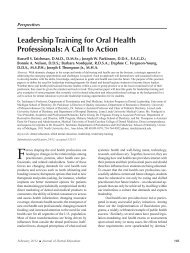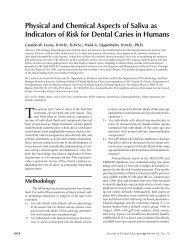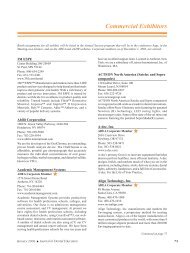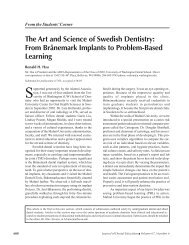List of Poster Presentations - Journal of Dental Education
List of Poster Presentations - Journal of Dental Education
List of Poster Presentations - Journal of Dental Education
You also want an ePaper? Increase the reach of your titles
YUMPU automatically turns print PDFs into web optimized ePapers that Google loves.
<strong>Poster</strong> Abstracts<br />
that they found the visualization <strong>of</strong> their current oral condition on the<br />
monitor as a valuable aid in understanding their dental needs. 88% <strong>of</strong><br />
the respondents understood the animated presentation <strong>of</strong> procedures<br />
that would be used in their treatment. 99% <strong>of</strong> the respondents indicated<br />
the mobile cart patient education system should be continued as an<br />
aid in understanding their oral conditions and various treatment<br />
modalities.<br />
A self-contained mobile cart system composed <strong>of</strong> high tech<br />
components can be used to demonstrate visually the existing oral<br />
condition <strong>of</strong> a patient and also animated dental procedures needed to<br />
restore oral health. This visualization greatly enhances the patient’s<br />
understanding <strong>of</strong> their dental needs and dental techniques used to<br />
restore them to oral health.<br />
71. Utilization <strong>of</strong> Intraoral Photography as a Diagnostic<br />
Tool and Aid in Assigning and Treating Patients in the<br />
<strong>Dental</strong> School and in Establishing a Baseline <strong>of</strong><br />
Pretreatment Oral Conditions<br />
Drahos, Gary L., University <strong>of</strong> Illinois College <strong>of</strong> Dentistry, Licari,<br />
Frank W., University <strong>of</strong> Illinois College <strong>of</strong> Dentistry, Burger-Zellinger,<br />
Rudolph, University <strong>of</strong> Illinois College <strong>of</strong> Dentistry<br />
Purpose: To develop an intraoral photographic system to record<br />
pretreatment oral conditions providing a valuable baseline tool in<br />
assigning patients to students and developing treatment plans for<br />
patients.<br />
Customarily, in dental schools across the U.S., new patients are<br />
given a general screening prior to admission and assignment to<br />
students. Color photographs taken at the initial appointment, along<br />
with dental charting and radiographs, provide a more complete<br />
diagnostic package. This allows quicker assignment to students in<br />
need <strong>of</strong> a particular type <strong>of</strong> dental patient. These photos consist <strong>of</strong><br />
full-face, right and left occlusion, anteriors, posteriors and any<br />
additional photos that would show specific areas <strong>of</strong> oral needs. After<br />
the photos are printed and made a part <strong>of</strong> the patient’s permanent<br />
treatment record, all materials are archived on a CD. The photos<br />
provide a visual representation <strong>of</strong> the patient’s needs. Photographs<br />
taken at the screening appointment also establish a baseline for the<br />
initial condition <strong>of</strong> the mouth and serve as a reference for future<br />
treatment and possible legal considerations. Mid-treatment and<br />
completed treatment photos will also be taken to finalize the records<br />
for future treatment convenience. Patient response at the time <strong>of</strong> taking<br />
the photos has been excellent when shown to them via a 17" monitor<br />
used for educational purposes. The intraoral camera and monitor are<br />
housed in a mobile cart for use throughout the school. The project<br />
was evaluated by an anonymous questionnaire <strong>of</strong> 130 students, faculty<br />
and staff. Ninety-nine percent (99%) <strong>of</strong> the respondents indicated<br />
that the photographs provided valuable information on the patients<br />
initial oral condition and should continue to be part <strong>of</strong> the patient’s<br />
initial exam and retained as a permanent part <strong>of</strong> the patients record.<br />
Eighty-six percent (86%) <strong>of</strong> the respondents indicated that the<br />
photographs provided a valuable aid in assigning patients to students<br />
and in the initial treatment planning phase.<br />
Taking intraoral photographs at the initial screening appointment<br />
provides a valuable diagnostic tool in providing a record <strong>of</strong> the initial<br />
oral condition <strong>of</strong> the patient as well as providing an aid in assigning<br />
patients and assisting students during initial treatment planning<br />
appointments.<br />
72. New Technologies in <strong>Dental</strong> <strong>Education</strong>: A Survey <strong>of</strong><br />
Second-year Tufts School <strong>of</strong> <strong>Dental</strong> Medicine Students<br />
Concerning PCs and the Internet<br />
Eisen, Debbie S., Tufts University School <strong>of</strong> <strong>Dental</strong> Medicine, Eisen,<br />
Steven E., Tufts University School <strong>of</strong> <strong>Dental</strong> Medicine<br />
The past decade has seen revolutionary changes in information<br />
technologies, which has made a significant impact on dental<br />
education. In this study we sought to begin assessment <strong>of</strong> how dental<br />
students are utilizing these new technologies.<br />
During the spring term <strong>of</strong> 2001, 2nd year dental students at<br />
Tufts University School <strong>of</strong> <strong>Dental</strong> Medicine were surveyed concerning<br />
their reliance upon new information modalities like PCs, and the<br />
Internet, as opposed to more traditional modalities such as lectures,<br />
class notes, and textbooks. Respondents were also asked what advice<br />
they would give incoming students concerning which modalities they<br />
ought to rely upon during their studies <strong>of</strong> dentistry. Out <strong>of</strong> a class <strong>of</strong><br />
145 students, fifty-five responded to this survey. 23 (41.8%)<br />
respondents reported owning a personal computer, 20 (36.4%) a<br />
laptop, 3 (5.5%) both, while 9 (16.4%) owned neither. 28 (50.9%)<br />
students reported their computer use in dental school to be about the<br />
same as in college, 12 (21.8%) reported increased computer usage,<br />
whereas only 10 (18.2%) said that their computer use was less than it<br />
was in college, and only 4 (7.3%) reported no use <strong>of</strong> the computer.<br />
Students were asked to rank sources <strong>of</strong> information, they would<br />
consult concerning technical dental issues. Instructors were ranked<br />
first by 24 (43.6%) respondents, lecture notes by 15 (27.3%),<br />
textbooks by 13 (23.6%), the Internet by 1 (1.8%). Two (3.6%)<br />
respondents included ‘other students’ as a first source <strong>of</strong> information.<br />
17 (30.9%) respondents ranked textbook as their second most<br />
important source <strong>of</strong> information, while 15 (27.3%) ranked lecture<br />
notes second, 11 (20%) instructors second, and 5 (9.1%) the Internet<br />
as their second most important source. 16 (29.1%) respondents judged<br />
that learning via the Internet was a great time-savings benefit, 35<br />
(63.6%) somewhat <strong>of</strong> a time-savings benefit and 4 (7.3%) found no<br />
time-savings benefit.<br />
New technologies like personal computers and the Internet are<br />
beginning to impact the way dental students are learning dentistry<br />
and are starting to replace reliance upon more traditional instructional<br />
modalities. In this study, we found that students’ perceptions<br />
concerning the Internet as having great time saving benefits does not<br />
match their actual usage <strong>of</strong> it as a primary or secondary source <strong>of</strong><br />
information. Possibly, current availability <strong>of</strong> useful information on<br />
the Internet may be a limiting factor as well as issues inherent with<br />
Internet access. As the technology improves and more resources<br />
become available on-line, then students’ usage may more closely<br />
reflect their expectations <strong>of</strong> the Internet’s usefulness as a learning<br />
tool.<br />
73. Faculty Publication Patterns Relative to Academic<br />
Rank and Tenure Status<br />
Fields, W. Thomas, University <strong>of</strong> Tennessee College <strong>of</strong> Dentistry,<br />
Scarbecz, Mark, University <strong>of</strong> Tennessee College <strong>of</strong> Dentistry<br />
Tw<strong>of</strong>old: Immediate - to describe patterns <strong>of</strong> faculty publication<br />
output. Long term - to provide a baseline to assess changes in such<br />
output following introduction <strong>of</strong> a new Post-Tenure Review process.<br />
In 2000, the University <strong>of</strong> Tennessee instituted a new Post-Tenure<br />
Review process, recurring every six years and closely mimicking<br />
criteria for the initial award <strong>of</strong> tenure, i.e., assessment <strong>of</strong> tenured<br />
faculty performance in the areas <strong>of</strong> teaching, scholarship, service<br />
and patient care. The implementation <strong>of</strong> such a process suggests the<br />
perception that additional encouragement may be needed to sustain<br />
continued faculty growth and performance beyond the attainment <strong>of</strong><br />
tenure. The purpose <strong>of</strong> this study is to determine if there is a discernible<br />
pattern <strong>of</strong> faculty publication productivity as faculty move through<br />
academic ranks and attain tenure. This initial descriptive study will<br />
provide a baseline for a six-year follow-up to see if the current pattern<br />
changes substantially following the introduction <strong>of</strong> the Post-Tenure<br />
Review. Ovid Medlines were run on each faculty member (85% FTE<br />
or greater). The Medlines were sent to the respective faculty for<br />
280 <strong>Journal</strong> <strong>of</strong> <strong>Dental</strong> <strong>Education</strong> ■ Volume 66, No. 2



